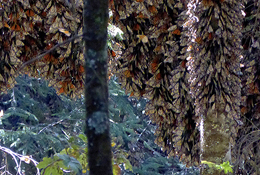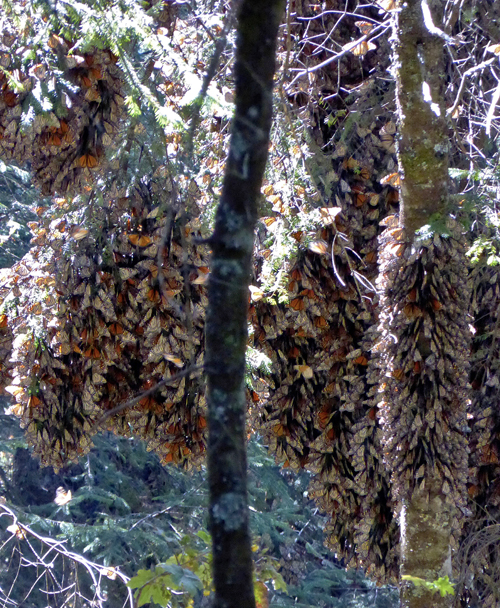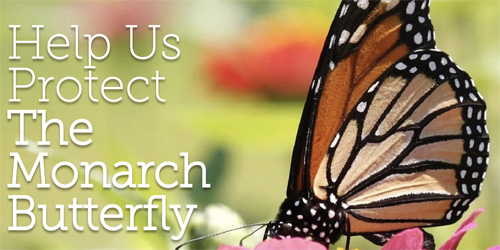
I was at Shepherd University the other day talking to Susie Munnis, who had just returned from San Miguel de Allende. This was her first trip to Mexico and I was anxious to hear how she liked it. She then told me that everyone at San Miguel was gushing over the “count” of the monarchs at the Mexican sanctuaries and planning to go see them. It’s about 100 miles between the two locales, and tours to the sanctuaries exist from San Miguel.
News about the 2018-19 monarch census began spiraling through cyberspace on Jan. 30, when Mexico released news that this year’s count was 6.05 hectares of monarchs at the sanctuaries, or about 15 acres. Last year, 2017-18, there were only 2.48 hectares, and when I visited the sanctuaries in 2014, the count was a dispiriting 0.67 hectares, the lowest in recorded time.
So how many monarchs are there in 6.05 hectares? When I got into the business a few years ago, Dr. Lincoln Brower, one of the giants in the field, used 60 million monarchs per hectare. I have heard Chip Taylor, director of Monarch Watch, the leading scientist on monarch migration, use the figure 12 million. About a year ago, the scientific community came up with the number 21 million on average, which is the number I use. That would translate to 127 million monarchs counted in 2019. I should add, 6 hectares of monarchs is exactly the acreage the federal government has posited as a “goal” for monarch survival, which would lower the probability of extinction.

So how did this happen? Why this year and not others? What made last year different? Does this bode well for the population, which has been in serious decline for more than 20 years?
Weather and timing, it turns out, is the great predictor of the monarch population. Taylor, the Monarch Watch director, predicted a bumper crop of monarchs in late spring of last year, based on favorable early- and late-spring weather as monarchs left Mexico on their journey north. I’m not sure you remember, but an early jet stream dipped into northern Texas and kept the area and points farther north in a cold spell during most of April. That, it turns out, is good for monarchs. The monarchs had great weather in Texas, several degrees above normal, and deposited their eggs there. Those eggs metamorphosed into adults in just 30 days. And from May 11 to 30, the “sweet spot” for the recolonization throughout much of the U.S. by the generation born in Texas, the temperatures were again well above normal.
Compared to the year before — 2017 — southerly winds in March and April sent the monarchs into the northern (summer breeding) reaches too soon, where, because of lower temperatures, it took about 45 days for the adults to emerge, and many arrived before the milkweed was up or succumbed to freezing temperatures.
So, what are the takeaways?
There is a weather and temporal sweet spot in monarch population dynamics. Taylor’s research has shown temperature and timing are key factors in monarch population growth. Does that mean there is an upside to climate change, that warmer temperatures are better for monarchs? Before we get carried away, we have to see what happens this spring.
When will the monarchs leave Mexico? Because of higher temperatures this year in the sanctuaries, monarch activity is high and there is concern they may be burning off their lipid reserves too soon. Some fear they will they leave Mexico before milkweed is up in Texas. Will major weather events — drenching rains, hurricanes, unusual freezes or wildfires — disturb the migration? The wildfires in California may have been responsible for decimating the Western population, which this year was only 28,429 monarchs. We have to answer these and other questions before we lay down our arms.
This piece was originally published in the Herald-Mail.
 Monarch Alliance on the web
Monarch Alliance on the web
Monarch Alliance on Facebook

The Monarch Alliance believes that the Monarch Butterfly and its extraordinary migration extending from Canada to the mountains of central Mexico has captured the imagination of millions of Americans.
The migration of this iconic animal species is in danger of disappearing because of the loss of milkweed and nectar sources throughout its breeding range in the United States and Canada and from threats to the Oyamel Fir forests in its overwintering sites in central Mexico.
The Monarch Alliance, working with other governmental and non-governmental organizations in Washington County and the surrounding region, will work to educate the public on the life cycle of the Monarch, threats to its spectacular migration, and how it can help by planting butterfly gardens, including milkweed native to our region.
MORE about the Monarch Alliance:
The Monarch Alliance (TMA) began as a Maryland-based group in Washington County and has expanded its reach into the eastern panhandle of West Virginia by partnering with the Potomac Valley Audubon Society. The main activities of TMA involve educating the public on the monarch life cycle, the threats to its spectacular migration, and how the public can help by planting native habitats and engaging in citizen science. One of the primary focuses of TMA is to engage students through outreach programs and the creation of the Junior Monarch Alliance! It is important to TMA to partner with local leaders who have regional expertise and can help share the monarch conservation message.
TMA is working to strengthen the monarch network in Maryland and West Virginia by partnering with the City of Hagerstown on the Mayors’ Monarch Pledge, through the installation of a Monarch Waystation (pictured above), conducting a butterfly and plant ID workshop, and putting on a spring milkweed sale and monarch tagging events at a new city park. They also host Monarch Discovery Days events in early September to celebrate the peak monarch migration in the area, hold monarch tagging events at the Antietam National Battlefield and the US Fish and Wildlife Service’s National Conservation Training Center (NCTC), and conduct extensive outreach both online and through presentations, booths, and other events.
In order to achieve their mission of supporting the monarch migration through education and outreach, TMA continues to build and maintain various partnerships locally. For example, they have a close relationship with Discovery Station, the local children’s science museum in Hagerstown, MD, which will be installing a monarch exhibit to further engage area youth. Through the Junior Monarch Alliance program, TMA and the museum host a program built around the Monarch Larva Monitoring Program. It is their aim to get children into the field to monitor milkweed each summer. They also work closely with the US Fish and Wildlife Service’s NCTC, the Washington County Master Gardeners, and the City of Hagerstown Parks and Recreation Department. Building these relationships has been key to TMA’s success.
TMA feels strongly about youth education to inspire a life-long commitment to conservation. Monarch butterflies are a tool for educators in fostering a long-standing relationship with conservation and serve as the flagship species for building knowledge about pollinators. Instilling this connection early in life will ensure that younger generations are ready to take the baton and continue to tackle the challenge of sustaining habitat for our nation’s wildlife.